Critical Appraisal of Evidence and Practice: HLSC122, Semester 1, 2019
VerifiedAdded on 2022/11/13
|6
|1453
|378
Report
AI Summary
This report provides a critical appraisal of the research paper by Day et al. (2018) investigating illicit drug use among music festival attendees. The report begins with an introduction to critical appraisal and its importance in evaluating scientific literature. Part A analyzes the paper's authorship, research questions, design, methods, results, and limitations, supported by academic references. The analysis highlights the strengths, such as the clearly stated aims and appropriate research design, while also pointing out the limitations of convenience sampling, self-reporting questionnaires, and potential gender bias. Part B discusses the application of the research findings to practice, considering a scenario where drug testing is implemented at music festivals. This section identifies enablers and barriers to using research evidence, such as the ability to retrieve and assess information, the local environment, time constraints, and the quality of the available evidence. The report concludes by emphasizing the importance of critical appraisal in evidence-based practice and summarizing the findings, while also acknowledging the limitations of the original study and the factors that influence the application of its findings.
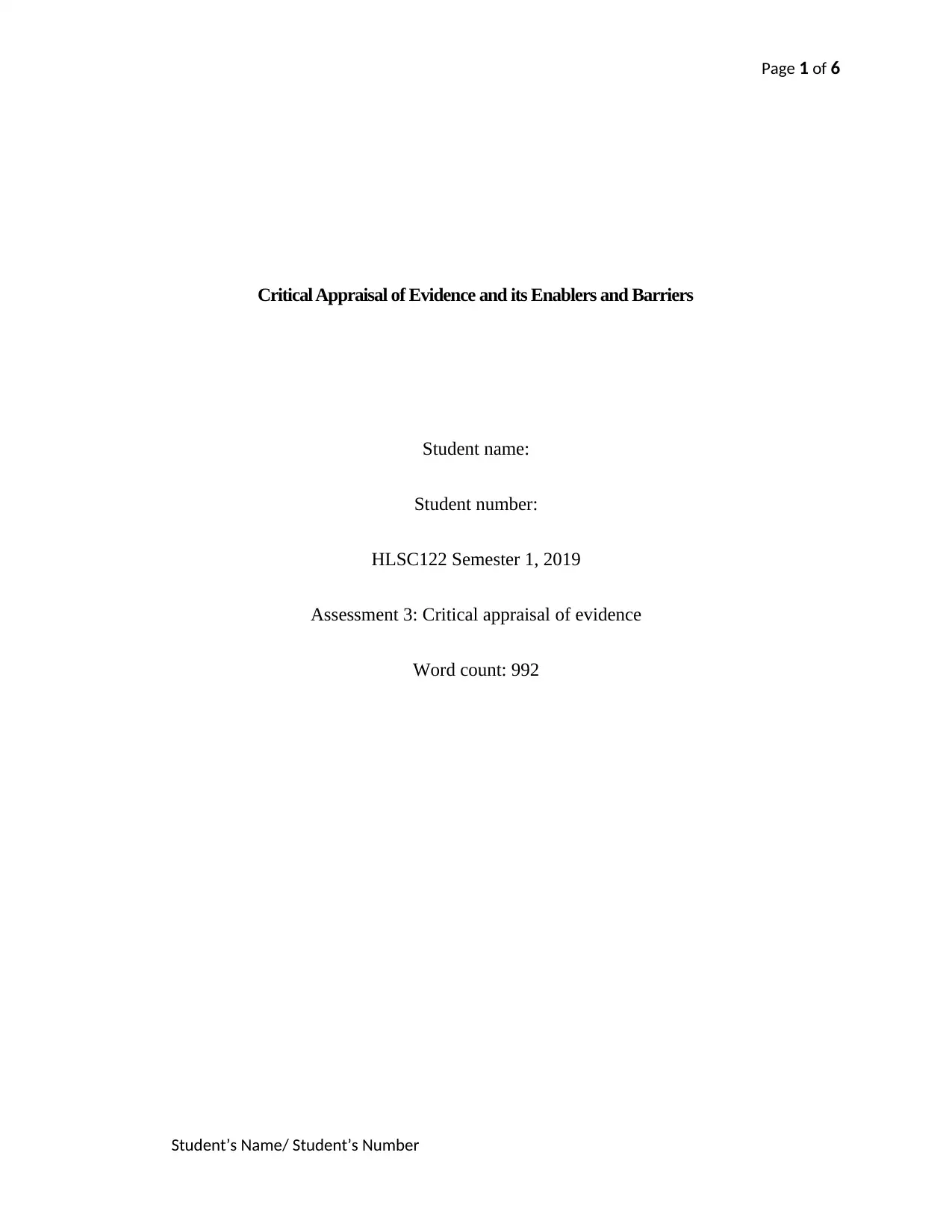
Page 1 of 6
Critical Appraisal of Evidence and its Enablers and Barriers
Student name:
Student number:
HLSC122 Semester 1, 2019
Assessment 3: Critical appraisal of evidence
Word count: 992
Student’s Name/ Student’s Number
Critical Appraisal of Evidence and its Enablers and Barriers
Student name:
Student number:
HLSC122 Semester 1, 2019
Assessment 3: Critical appraisal of evidence
Word count: 992
Student’s Name/ Student’s Number
Paraphrase This Document
Need a fresh take? Get an instant paraphrase of this document with our AI Paraphraser
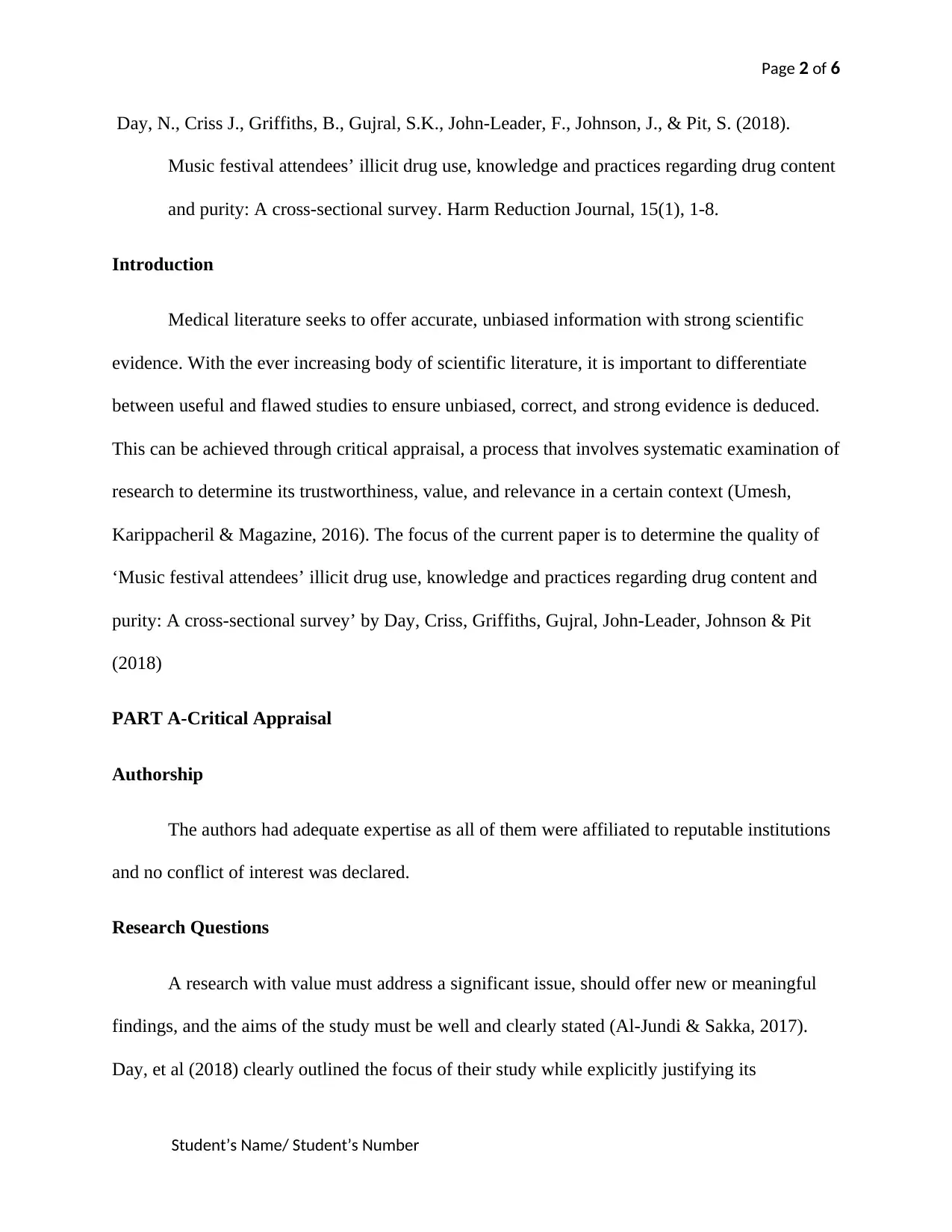
Page 2 of 6
Day, N., Criss J., Griffiths, B., Gujral, S.K., John-Leader, F., Johnson, J., & Pit, S. (2018).
Music festival attendees’ illicit drug use, knowledge and practices regarding drug content
and purity: A cross-sectional survey. Harm Reduction Journal, 15(1), 1-8.
Introduction
Medical literature seeks to offer accurate, unbiased information with strong scientific
evidence. With the ever increasing body of scientific literature, it is important to differentiate
between useful and flawed studies to ensure unbiased, correct, and strong evidence is deduced.
This can be achieved through critical appraisal, a process that involves systematic examination of
research to determine its trustworthiness, value, and relevance in a certain context (Umesh,
Karippacheril & Magazine, 2016). The focus of the current paper is to determine the quality of
‘Music festival attendees’ illicit drug use, knowledge and practices regarding drug content and
purity: A cross-sectional survey’ by Day, Criss, Griffiths, Gujral, John-Leader, Johnson & Pit
(2018)
PART A-Critical Appraisal
Authorship
The authors had adequate expertise as all of them were affiliated to reputable institutions
and no conflict of interest was declared.
Research Questions
A research with value must address a significant issue, should offer new or meaningful
findings, and the aims of the study must be well and clearly stated (Al-Jundi & Sakka, 2017).
Day, et al (2018) clearly outlined the focus of their study while explicitly justifying its
Student’s Name/ Student’s Number
Day, N., Criss J., Griffiths, B., Gujral, S.K., John-Leader, F., Johnson, J., & Pit, S. (2018).
Music festival attendees’ illicit drug use, knowledge and practices regarding drug content
and purity: A cross-sectional survey. Harm Reduction Journal, 15(1), 1-8.
Introduction
Medical literature seeks to offer accurate, unbiased information with strong scientific
evidence. With the ever increasing body of scientific literature, it is important to differentiate
between useful and flawed studies to ensure unbiased, correct, and strong evidence is deduced.
This can be achieved through critical appraisal, a process that involves systematic examination of
research to determine its trustworthiness, value, and relevance in a certain context (Umesh,
Karippacheril & Magazine, 2016). The focus of the current paper is to determine the quality of
‘Music festival attendees’ illicit drug use, knowledge and practices regarding drug content and
purity: A cross-sectional survey’ by Day, Criss, Griffiths, Gujral, John-Leader, Johnson & Pit
(2018)
PART A-Critical Appraisal
Authorship
The authors had adequate expertise as all of them were affiliated to reputable institutions
and no conflict of interest was declared.
Research Questions
A research with value must address a significant issue, should offer new or meaningful
findings, and the aims of the study must be well and clearly stated (Al-Jundi & Sakka, 2017).
Day, et al (2018) clearly outlined the focus of their study while explicitly justifying its
Student’s Name/ Student’s Number

Page 3 of 6
importance. More precisely, the authors stated that there lack prior research studies investigating
drug checking services while drawing participants from a music festival.
Research Design
The appropriateness of the study design to the research question is essential in
determining the usefulness of the study. Day et al (2018) used a cross-sectional survey, an
appropriate considering that they were investigating illicit drug use behaviors of participants at
one point in time. As (Parker & Berman, 2016) outlines, cross-sectional surveys are appropriate
for providing a description of specific issues or risk factors without making attempts to infer
causal associations.
Research Methods
A good working research question coupled with a strong methodology is a channel for
conducting a meaningful research (Umesh, Karrippacheril, & Magazine, 2016). Day, et al (2018)
used convenience sampling to select participants, and developed a survey instrument for the
purposes of the research to aid in data collection. Convenience sampling may have reduced the
quality of the study by reducing its generalizability as the selected participants were most likely
not to be a representative sample of the general population. Also, the included participants were
comprised of 60.5 % females, an aspect that may have introduced gender bias further limiting
generalizability of findings. However, essential information regarding the sample was provided
including properly defined sample, eligibility criteria, how sample was recruited, and where the
study was performed.
Use of a survey questionnaire to collect data was an appropriate choice as it allowed large
population to be evaluated with relative ease. The survey tool was developed using guidance of
Student’s Name/ Student’s Number
importance. More precisely, the authors stated that there lack prior research studies investigating
drug checking services while drawing participants from a music festival.
Research Design
The appropriateness of the study design to the research question is essential in
determining the usefulness of the study. Day et al (2018) used a cross-sectional survey, an
appropriate considering that they were investigating illicit drug use behaviors of participants at
one point in time. As (Parker & Berman, 2016) outlines, cross-sectional surveys are appropriate
for providing a description of specific issues or risk factors without making attempts to infer
causal associations.
Research Methods
A good working research question coupled with a strong methodology is a channel for
conducting a meaningful research (Umesh, Karrippacheril, & Magazine, 2016). Day, et al (2018)
used convenience sampling to select participants, and developed a survey instrument for the
purposes of the research to aid in data collection. Convenience sampling may have reduced the
quality of the study by reducing its generalizability as the selected participants were most likely
not to be a representative sample of the general population. Also, the included participants were
comprised of 60.5 % females, an aspect that may have introduced gender bias further limiting
generalizability of findings. However, essential information regarding the sample was provided
including properly defined sample, eligibility criteria, how sample was recruited, and where the
study was performed.
Use of a survey questionnaire to collect data was an appropriate choice as it allowed large
population to be evaluated with relative ease. The survey tool was developed using guidance of
Student’s Name/ Student’s Number
⊘ This is a preview!⊘
Do you want full access?
Subscribe today to unlock all pages.

Trusted by 1+ million students worldwide
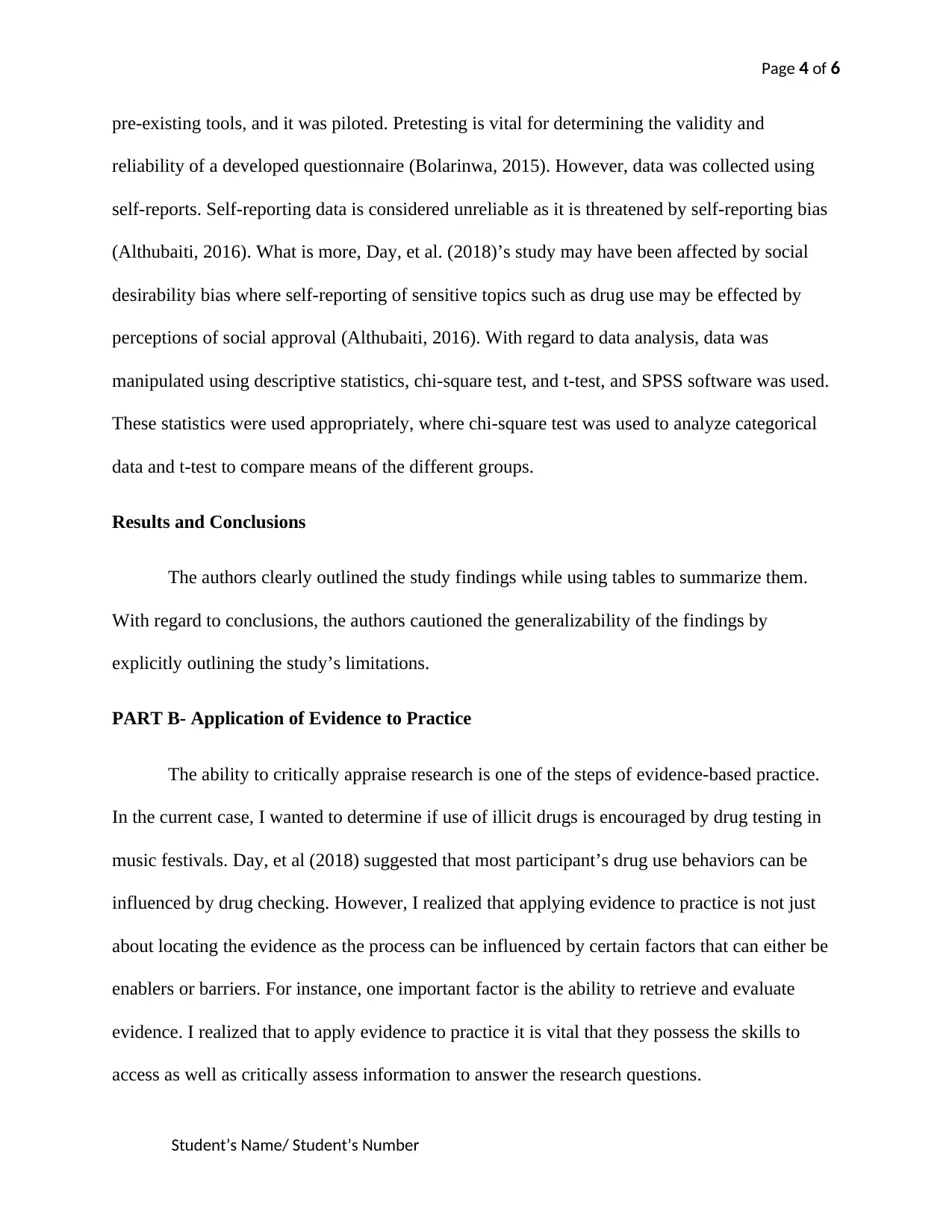
Page 4 of 6
pre-existing tools, and it was piloted. Pretesting is vital for determining the validity and
reliability of a developed questionnaire (Bolarinwa, 2015). However, data was collected using
self-reports. Self-reporting data is considered unreliable as it is threatened by self-reporting bias
(Althubaiti, 2016). What is more, Day, et al. (2018)’s study may have been affected by social
desirability bias where self-reporting of sensitive topics such as drug use may be effected by
perceptions of social approval (Althubaiti, 2016). With regard to data analysis, data was
manipulated using descriptive statistics, chi-square test, and t-test, and SPSS software was used.
These statistics were used appropriately, where chi-square test was used to analyze categorical
data and t-test to compare means of the different groups.
Results and Conclusions
The authors clearly outlined the study findings while using tables to summarize them.
With regard to conclusions, the authors cautioned the generalizability of the findings by
explicitly outlining the study’s limitations.
PART B- Application of Evidence to Practice
The ability to critically appraise research is one of the steps of evidence-based practice.
In the current case, I wanted to determine if use of illicit drugs is encouraged by drug testing in
music festivals. Day, et al (2018) suggested that most participant’s drug use behaviors can be
influenced by drug checking. However, I realized that applying evidence to practice is not just
about locating the evidence as the process can be influenced by certain factors that can either be
enablers or barriers. For instance, one important factor is the ability to retrieve and evaluate
evidence. I realized that to apply evidence to practice it is vital that they possess the skills to
access as well as critically assess information to answer the research questions.
Student’s Name/ Student’s Number
pre-existing tools, and it was piloted. Pretesting is vital for determining the validity and
reliability of a developed questionnaire (Bolarinwa, 2015). However, data was collected using
self-reports. Self-reporting data is considered unreliable as it is threatened by self-reporting bias
(Althubaiti, 2016). What is more, Day, et al. (2018)’s study may have been affected by social
desirability bias where self-reporting of sensitive topics such as drug use may be effected by
perceptions of social approval (Althubaiti, 2016). With regard to data analysis, data was
manipulated using descriptive statistics, chi-square test, and t-test, and SPSS software was used.
These statistics were used appropriately, where chi-square test was used to analyze categorical
data and t-test to compare means of the different groups.
Results and Conclusions
The authors clearly outlined the study findings while using tables to summarize them.
With regard to conclusions, the authors cautioned the generalizability of the findings by
explicitly outlining the study’s limitations.
PART B- Application of Evidence to Practice
The ability to critically appraise research is one of the steps of evidence-based practice.
In the current case, I wanted to determine if use of illicit drugs is encouraged by drug testing in
music festivals. Day, et al (2018) suggested that most participant’s drug use behaviors can be
influenced by drug checking. However, I realized that applying evidence to practice is not just
about locating the evidence as the process can be influenced by certain factors that can either be
enablers or barriers. For instance, one important factor is the ability to retrieve and evaluate
evidence. I realized that to apply evidence to practice it is vital that they possess the skills to
access as well as critically assess information to answer the research questions.
Student’s Name/ Student’s Number
Paraphrase This Document
Need a fresh take? Get an instant paraphrase of this document with our AI Paraphraser
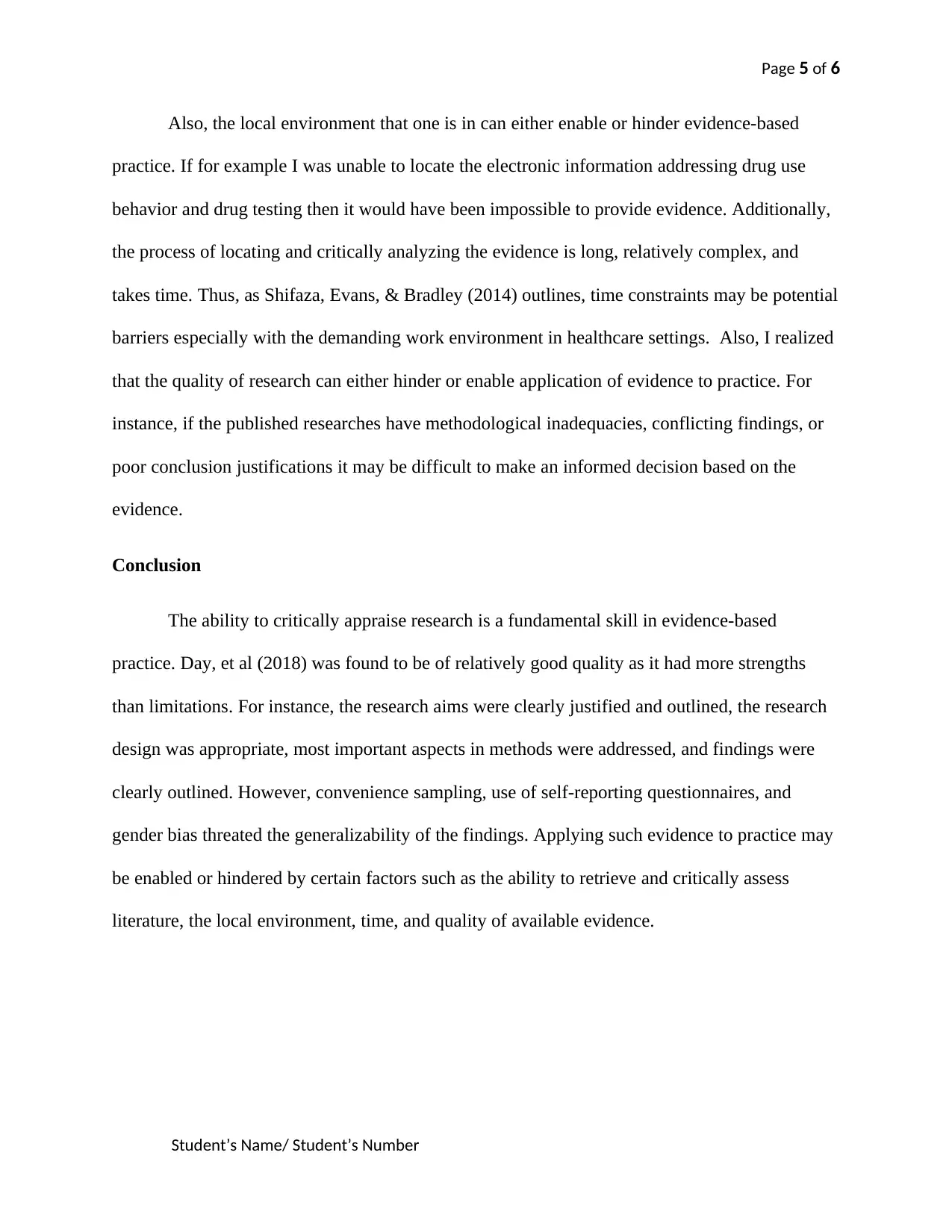
Page 5 of 6
Also, the local environment that one is in can either enable or hinder evidence-based
practice. If for example I was unable to locate the electronic information addressing drug use
behavior and drug testing then it would have been impossible to provide evidence. Additionally,
the process of locating and critically analyzing the evidence is long, relatively complex, and
takes time. Thus, as Shifaza, Evans, & Bradley (2014) outlines, time constraints may be potential
barriers especially with the demanding work environment in healthcare settings. Also, I realized
that the quality of research can either hinder or enable application of evidence to practice. For
instance, if the published researches have methodological inadequacies, conflicting findings, or
poor conclusion justifications it may be difficult to make an informed decision based on the
evidence.
Conclusion
The ability to critically appraise research is a fundamental skill in evidence-based
practice. Day, et al (2018) was found to be of relatively good quality as it had more strengths
than limitations. For instance, the research aims were clearly justified and outlined, the research
design was appropriate, most important aspects in methods were addressed, and findings were
clearly outlined. However, convenience sampling, use of self-reporting questionnaires, and
gender bias threated the generalizability of the findings. Applying such evidence to practice may
be enabled or hindered by certain factors such as the ability to retrieve and critically assess
literature, the local environment, time, and quality of available evidence.
Student’s Name/ Student’s Number
Also, the local environment that one is in can either enable or hinder evidence-based
practice. If for example I was unable to locate the electronic information addressing drug use
behavior and drug testing then it would have been impossible to provide evidence. Additionally,
the process of locating and critically analyzing the evidence is long, relatively complex, and
takes time. Thus, as Shifaza, Evans, & Bradley (2014) outlines, time constraints may be potential
barriers especially with the demanding work environment in healthcare settings. Also, I realized
that the quality of research can either hinder or enable application of evidence to practice. For
instance, if the published researches have methodological inadequacies, conflicting findings, or
poor conclusion justifications it may be difficult to make an informed decision based on the
evidence.
Conclusion
The ability to critically appraise research is a fundamental skill in evidence-based
practice. Day, et al (2018) was found to be of relatively good quality as it had more strengths
than limitations. For instance, the research aims were clearly justified and outlined, the research
design was appropriate, most important aspects in methods were addressed, and findings were
clearly outlined. However, convenience sampling, use of self-reporting questionnaires, and
gender bias threated the generalizability of the findings. Applying such evidence to practice may
be enabled or hindered by certain factors such as the ability to retrieve and critically assess
literature, the local environment, time, and quality of available evidence.
Student’s Name/ Student’s Number
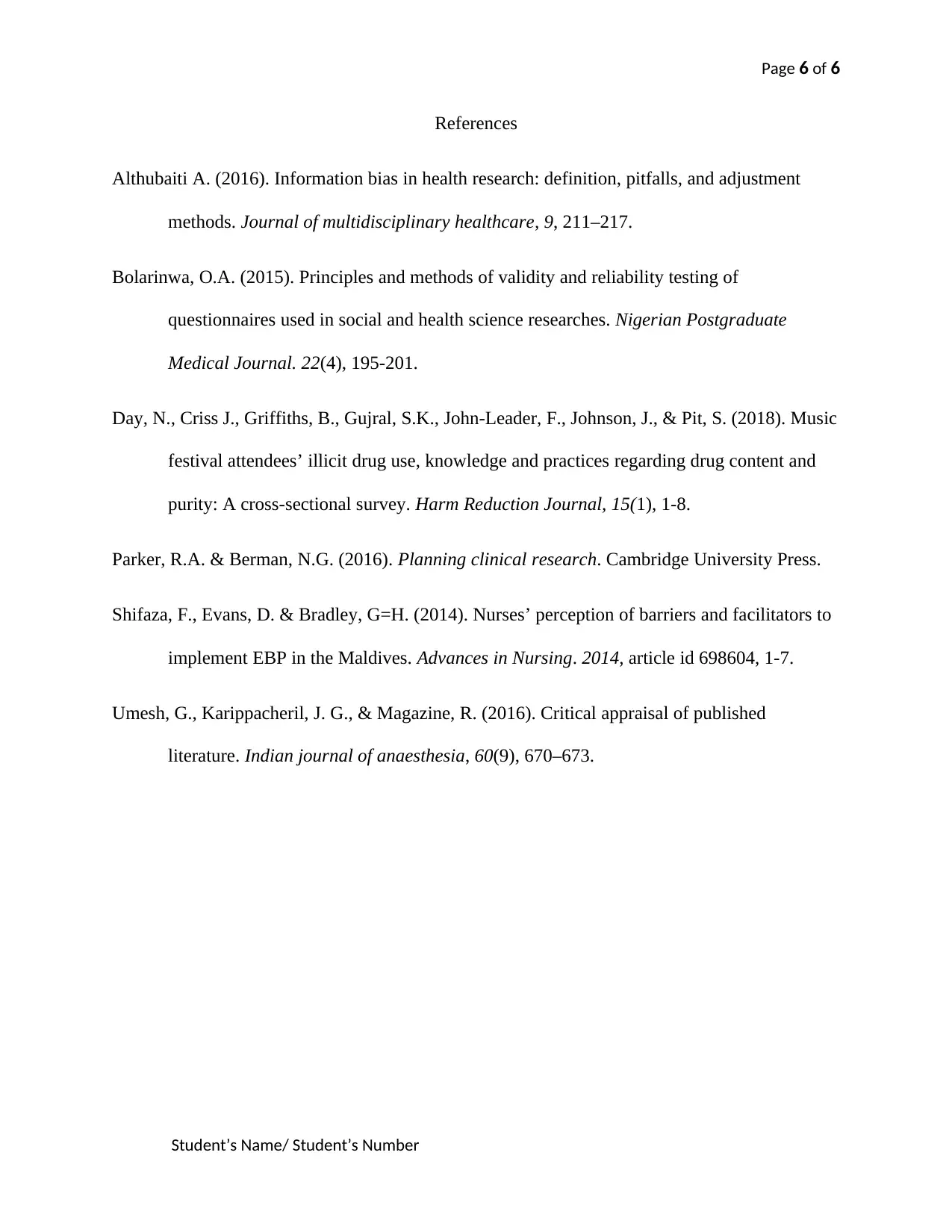
Page 6 of 6
References
Althubaiti A. (2016). Information bias in health research: definition, pitfalls, and adjustment
methods. Journal of multidisciplinary healthcare, 9, 211–217.
Bolarinwa, O.A. (2015). Principles and methods of validity and reliability testing of
questionnaires used in social and health science researches. Nigerian Postgraduate
Medical Journal. 22(4), 195-201.
Day, N., Criss J., Griffiths, B., Gujral, S.K., John-Leader, F., Johnson, J., & Pit, S. (2018). Music
festival attendees’ illicit drug use, knowledge and practices regarding drug content and
purity: A cross-sectional survey. Harm Reduction Journal, 15(1), 1-8.
Parker, R.A. & Berman, N.G. (2016). Planning clinical research. Cambridge University Press.
Shifaza, F., Evans, D. & Bradley, G=H. (2014). Nurses’ perception of barriers and facilitators to
implement EBP in the Maldives. Advances in Nursing. 2014, article id 698604, 1-7.
Umesh, G., Karippacheril, J. G., & Magazine, R. (2016). Critical appraisal of published
literature. Indian journal of anaesthesia, 60(9), 670–673.
Student’s Name/ Student’s Number
References
Althubaiti A. (2016). Information bias in health research: definition, pitfalls, and adjustment
methods. Journal of multidisciplinary healthcare, 9, 211–217.
Bolarinwa, O.A. (2015). Principles and methods of validity and reliability testing of
questionnaires used in social and health science researches. Nigerian Postgraduate
Medical Journal. 22(4), 195-201.
Day, N., Criss J., Griffiths, B., Gujral, S.K., John-Leader, F., Johnson, J., & Pit, S. (2018). Music
festival attendees’ illicit drug use, knowledge and practices regarding drug content and
purity: A cross-sectional survey. Harm Reduction Journal, 15(1), 1-8.
Parker, R.A. & Berman, N.G. (2016). Planning clinical research. Cambridge University Press.
Shifaza, F., Evans, D. & Bradley, G=H. (2014). Nurses’ perception of barriers and facilitators to
implement EBP in the Maldives. Advances in Nursing. 2014, article id 698604, 1-7.
Umesh, G., Karippacheril, J. G., & Magazine, R. (2016). Critical appraisal of published
literature. Indian journal of anaesthesia, 60(9), 670–673.
Student’s Name/ Student’s Number
⊘ This is a preview!⊘
Do you want full access?
Subscribe today to unlock all pages.

Trusted by 1+ million students worldwide
1 out of 6
Related Documents
Your All-in-One AI-Powered Toolkit for Academic Success.
+13062052269
info@desklib.com
Available 24*7 on WhatsApp / Email
![[object Object]](/_next/static/media/star-bottom.7253800d.svg)
Unlock your academic potential
Copyright © 2020–2025 A2Z Services. All Rights Reserved. Developed and managed by ZUCOL.





